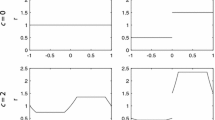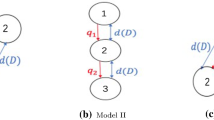Abstract
The dispersal patterns of animals moving through heterogeneous environments have important ecological and epidemiological consequences. In this work, we apply the method of homogenization to analyze an advection–diffusion (AD) model of directed movement in a one-dimensional environment in which the scale of the heterogeneity is small relative to the spatial scale of interest. We show that the large (slow) scale behavior is described by a constant-coefficient diffusion equation under certain assumptions about the fast-scale advection velocity, and we determine a formula for the slow-scale diffusion coefficient in terms of the fast-scale parameters. We extend the homogenization result to predict invasion speeds for an advection–diffusion–reaction (ADR) model with directed dispersal. For periodic environments, the homogenization approximation of the solution of the AD model compares favorably with numerical simulations. Invasion speed approximations for the ADR model also compare favorably with numerical simulations when the spatial period is sufficiently small.





Similar content being viewed by others
References
Armsworth PR, Bode L (1999) The consequences of non-passive advection and directed motion for population dynamics. Proc R Soc Lond A 455:4045–4060
Armsworth PR, Roughgarden JE (2005) The impact of directed versus random movement on population dynamics and biodiversity patterns. Am Nat 165:449–465
Banks HT, Kareiva PM, Zia L (1988) Analyzing field studies of insect dispersal using two-dimensional transport equations. Env Entomol 17:815–820
Dewhirst S, Lutscher F (2009) Dispersal in heterogeneous habitats: thresholds, spatial scales, and approximate rates of spread. Ecology 90:1338–1345
Fitzgibbon WE, Langlais M, Morgan J (2001) A mathematical model of the spread of feline leukemia virus (FeLV) through a highly heterogeneous spatial domain. SIAM J Math Anal 19:570–588
Garlick MJ, Powell JA, Hooten MB, MacFarlane LR (2011) Homogenization of large-scale movement models in ecology. Bull Math Biol 73:2088–2108
Garlick MJ, Powell JA, Hooten MB, MacFarlane LR (2013) Homogenization, sex, and differential motility predict spread of chronic wasting disease in mule deer in southern Utah. J Math Biol 69:369–399
Goudon T, Poupaud F (2004) Homogenization of transport equations: weak mean field approximation. SIAM J Math Anal 36(3):856–881
Goudon T, Poupaud F (2007) Homogenization of transport equations: a simple PDE approach to the Kubo formula. Bull Sci Math 131:72–88
Hastings A, Cuddington K, Davies KF, Dugaw CJ, Elmendorf S, Freestone A, Harrison S, Holland M, Lambrinos J, Malvadkar U, Melbourne BA, Moore K, Taylor C, Thomson D (2005) The spatial spread of invasions: new developments in theory and evidence. Ecol Lett 8:91–101
Holmes EE, Lewis MA, Banks JE, Veit RR (1994) Partial differential equations in ecology: spatial interactions and population dynamics. Ecology 75:17–29
Holmes MH (2013) Introduction to perturbation methods. Springer, New York
Jikov VV, Kozlov SM, Oleinik OA (1991) Homogenization of differential operators and integral functionals. Springer, Berlin
Kareiva PM (1983) Local movement in herbivorous insects: applying a passive diffusion model to mark-recapture field experiments. Oecologia 57:322–327
Kawasaki K, Shigesada N (2007) An integrodifference model for biological invasions in a periodically fragmented environment. Jpn J Ind Appl Math 24:3–15
Kawasaki K, Asano K, Shigesada N (2012) Impact of directed movement on invasive spread in periodic patchy environments. Bull Math Biol 74:1448–1467
Kolmogoroff A, Petrovsky I, Piscounoff N (1937) Étude de l‘équation de la diffusion avec croissance de la quantité de matiére et son application á une probléme biologique. Moscow Univ Math Bull 1:1–25
Lutscher F, Lewis MA, McCauley E (2006) Effects of heterogeneity on spread and persistence in rivers. Bull Math Biol 68:2129–2160
Maciel GA, Lutscher F (2013) How individual movement response to habitat edges affects population persistence and spatial spread. Am Nat 182:42–52
Moorcroft PR, Lewis MA (2006) Mechanistic home range analysis. Princeton University Press, Princeton
Neubert MG, Kot M, Lewis MA (1995) Dispersal and pattern formation in a discrete-time predator–prey model. Theor Pop Biol 48:7–43
Okubo A, Levin SA (2001) Diffusion and ecological problems: modern perspectives. Springer, New York
Ostfeld RS, Glass GE, Keesing F (2005) Spatial epidemiology: an emerging (or re-emerging) discipline. TRENDS Ecol Evol 20:328–336
Patlak CS (1953) Random walk with persistence and external bias. Bull Math Biophys 15:311–338
Pavliotis GA, Stuart AM (2008) Multiscale methods: averaging and homogenization. Springer, New York
Powell JA, Zimmermann NE (2004) Multiscale analysis of active seed dispersal contributes to resolving Reid’s paradox. Ecology 85:490–506
Roques L, Stoica RS (2007) Species persistence decreases with habitat fragmentation: an analysis in periodic stochastic environments. J Math Biol 55:189–205
Shigesada N, Kawasaki K, Teramoto E (1979) Spatial segregation of interacting species. J Theor Biol 79:83–99
Shigesada N, Kawasaki K, Teramoto E (1986) Traveling periodic waves in heterogeneous environments. Theor Popul Biol 30:143–160
Skellam JG (1951) Random dispersal in theoretical populations. Biometrika 38:196–218
Turchin P (1998) Quantitative analysis of movement: measuring and modeling population redistribution in animals and plants. Sinauer, Sunderland
Uchiyama K (1978) The behavior of solutions of some nonlinear diffusion equations for large time. J Math Kyoto Univ 18:453–508
Van Kirk RW, Lewis M (1997) Integrodifference models for persistence in fragmented habitats. Bull Math Biol 59:107–137
Vergassola M, Avellaneda M (1997) Scalar transport in compressible flow. Physica D 106:148–166
With KA (2004) Assessing the risk of invasive spread in fragmented landscapes. Risk Anal 24:803–815
Acknowledgments
I thank Aaron Cinzori and K. Greg Murray for providing valuable discussion, and Michelle Yurk for assistance running numerical simulations. I also thank an anonymous reviewer for valuable feedback on this manuscript.
Author information
Authors and Affiliations
Corresponding author
Additional information
This work was supported by a Jacob E. Nyenhuis Faculty Development Grant from Hope College, funded by the Willard C. Wichers Faculty Development Fund.
Appendix: Homogenized Diffusion Coefficient for Periodic, Zero Mean Velocity
Appendix: Homogenized Diffusion Coefficient for Periodic, Zero Mean Velocity
We derive the simple formula (73) for the diffusion coefficient (28) in the case that the advection velocity u is periodic (29) with zero mean (30). These two conditions imply that I and its reciprocal, \(I^{-1}\) are also periodic with period \(2\ell \),
For convenience, we set the lower limits of integration to \(y_0=-\ell \) in the definitions of I, \(\gamma \), and \(\alpha \) (5, 14, 24).
From the definition of \(\alpha \) (24),
Since we are interested in the limit as \(y\rightarrow \infty \) in (28), we may assume that \(y>0\) in what follows. In this case, \(\alpha \) can be expressed as the sum
where m is chosen so that
Since \(I^{-1}\) is periodic with period \(2\ell \), each of last m terms on the right-hand side of (55) are equal to \(\int _{-\ell }^{\ell } I^{-1}(s)\,\hbox {d}s\). Consequently,
Now, we turn our attention to the integral in the denominator of (28). Similar to above, we express the integral as the sum
where n is chosen so that
We will develop bounds for the last n terms on the right-hand side of (58). The limits of integration of these integrals restrict the relevant values of s, so that \(\alpha (s)\) needs only to be considered for \((2i-1)\ell \le s<(2i+1)\ell \). Thus, according to (57) and (56), these integrals can be rewritten as,
Because I and \(I^{-1}\) are positive, the double-integral on the right-hand side of Eq. (60) must also be positive. Furthermore, the assumption (6) implies that \(I(s)\le I_M\) and \(I^{-1}(s)\le (I_m)^{-1}\), for all \(s\in \mathbb {R}^1\), where \(I_M\) and \(I_m\) are fixed positive real numbers. Consequently,
Next, we develop bounds for the first term on the right-hand side of Eq. (58). First, note that since \(\alpha (s)\) is a positive, increasing function and \(y\ge (2n-1)\ell \),
Inequality (59) also implies that
The two preceding inequalities, along with (6) result in the following bound:
Using inequalities (61) and (64) and equations (58) and (60), we arrive at the upper bound
and the lower bound
Inequality (59) implies that
Consequently,
as \(y\rightarrow \infty \). Furthermore, the last two terms on the right-hand side of the upper bound (65) satisfy
and
Finally, we evaluate the limit
which arises in the formula for the diffusion coefficient (28). Note that if the right-hand side of the upper bound (65) is divided by \(y^2\), and the limit taken as \(y\rightarrow \infty \), we obtain
due to (68–70). The same limit is obtained if the right-hand side of the lower bound (66) is divided by \(y^2\). Thus, by the Squeeze Theorem, the limit (71) is given by the expression (72). Consequently, from this limit and Eq. (28), we can conclude that the slow-scale diffusion coefficient for a periodic, zero-mean velocity is simply
where \(I_{av}\) is the average value of I,
and \(I^{-1}_\mathrm{av}\) is the average value of \(I^{-1}\),
Rights and permissions
About this article
Cite this article
Yurk, B.P. Homogenization of a Directed Dispersal Model for Animal Movement in a Heterogeneous Environment. Bull Math Biol 78, 2034–2056 (2016). https://doi.org/10.1007/s11538-016-0210-0
Received:
Accepted:
Published:
Issue Date:
DOI: https://doi.org/10.1007/s11538-016-0210-0




